Bang for Buck: Bagration German Artillery Options
By Richard Steer
provides Late-War German forces in with a wealth of list building options, including a wide variety of artillery units. Following on from last month’s article , it makes sense to subject the other side the same scrutiny.
To recap, the analysis a model that simulates each dice roll in the scenario being tested to find an outcome, then repeats that simulation thousands of times in order to find the likelihood of each particular outcome occurring. The targets are dug in Careful infantry teams, with five teams under the Artillery Template, or nine teams under a Salvo Template. The other assumptions are that the Spotting Team is the Formation Commander, and a +1 penalty is added for Ranging In on terrain.
The caveat is that this analysis presents a long term average outcome for a specific scenario. How a particular unit performs in a game will depend on a wide range of factors including terrain, players’ tactical choices, the makeup of the opposing force, and perhaps most importantly, the luck of the dice.
 Average Performance
Average Performance
The first comparison of how effective an artillery unit is the average number of teams it will destroy in a turn. This chart has two colors. The blue bars are for the turn that it attempts to Range In. This includes the three attempts to Range In, and the impact that has on the score To Hit. The red bars are for a Repeat Bombardment, with the target teams rerolling saves.
The chart also includes a unit of 2 x 7.5cm infantry guns firing direct at Concealed Careful infantry teams at Short Range, to see how that compares to using them as artillery.
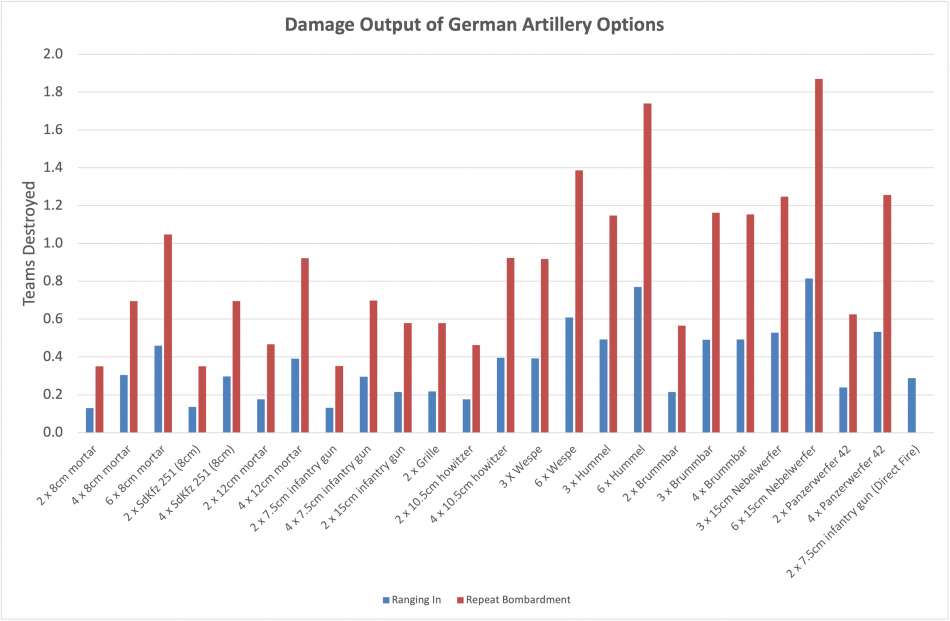
The striking thing about these numbers is how bad the two-gun batteries are. The like-for-like comparison of the 7.5cm infantry gun shows that a Repeat Bombardment is only slightly better than normal Shooting. The best of the two-gun batteries are those that are armed with 15cm guns, but even these have less than a 1-in-5 chance of doing any damage, and it’s 50/50 whether they will even achieve a Pinned Down result.
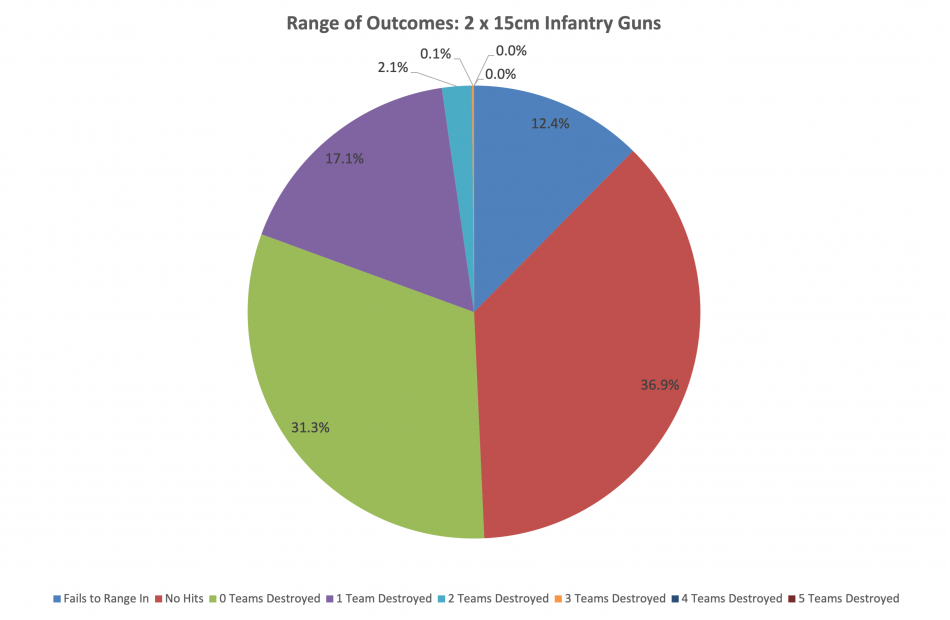
Taking the average damage output of the unit and dividing it by the cost of the unit gives a measure of cost-effectiveness. There are lots of factors that will affect this number. In particular, mortars and rocket launchers will always be more cost-effective than other weapons, because they are not paying for a direct-fire capability.
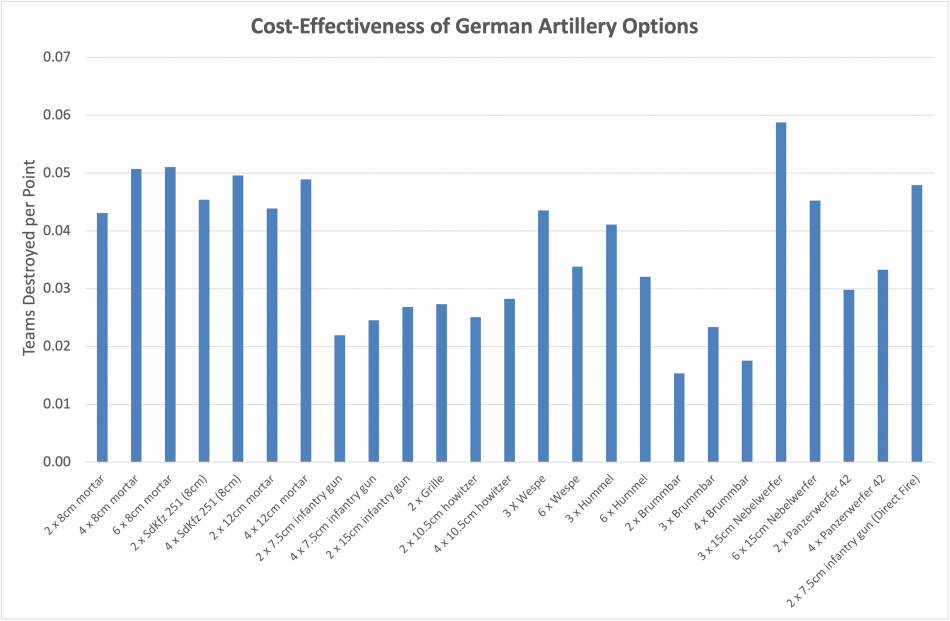
The top spot is held by the 15cm Nebelwerfer. Its key advantage is that it uses the Salvo Template, with the analysis assuming that it will catch nine teams, compared to five teams under the normal Artillery Template. The results are quite sensitive to this assumption: the Nebelwerfer becomes less cost-effective than the mortars when there are seven or fewer teams under its template.
The most cost-effective artillery unit with a direct fire capability is a unit of three Wespes. It benefits from delivering the same bombardment as the towed battery of four 10.5cm Howitzers, while only paying for three guns instead of four, and getting a 0.5 point per gun discount on top of that. All of the towed guns look very inefficient in comparison.
 Durability
Durability
To assess how well a unit can continue to function over the course of a game, I have included two tests involving an attack by my favorite unit for hunting down backfield units: the British Typhoon Fighter-bomber Flight. For the first test, the two Typhoons are attacking with Rockets. The aircraft arrive and attempt to Range In, Destroyed teams are removed, pinning, remounts and Last Stand tests are assessed if needed, and then the artillery unit attempts to fire a bombardment. The second test follows a similar pattern using the Typhoons’ cannons instead of rockets.
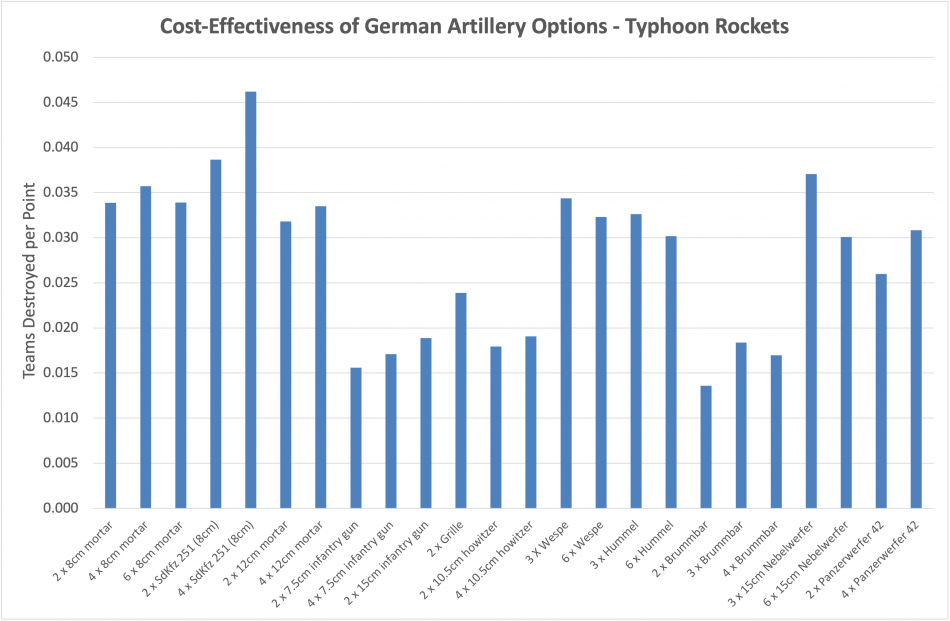
When attacked with rockets, most units lose about a third of their effectiveness, largely due to the chance of failing to Rally. Self-propelled units perform significantly better, despite the Typhoon’s Anti-tank 5 being very high for a bombardment, because they cannot be Pinned Down and typically only lose less than 20% of their effectiveness.
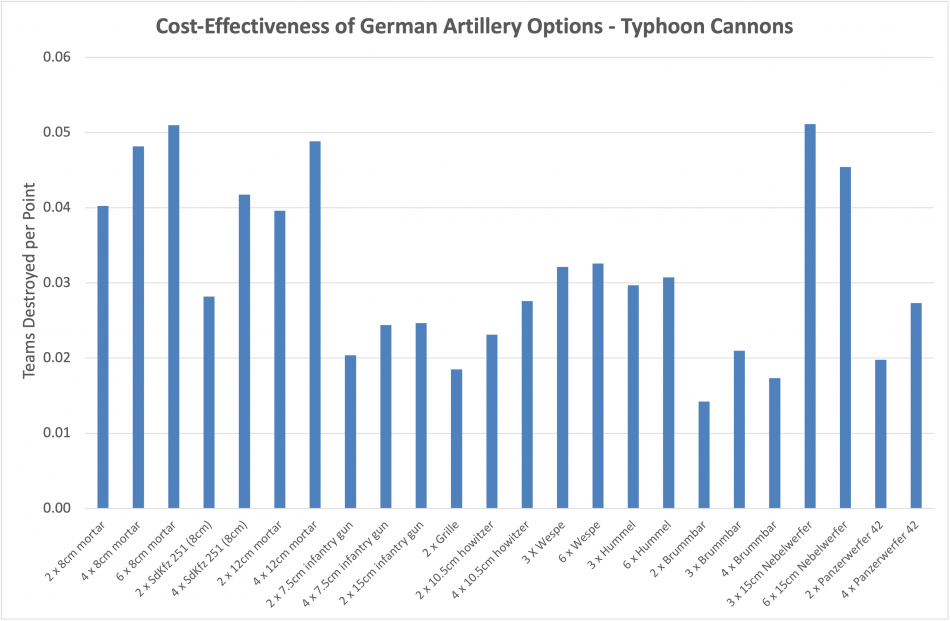
Aircraft cannons are a bad matchup for lightly armored self-propelled units like Wespes. They don’t benefit from Concealment, they don’t get a meaningful save against the Typhoon’s Anti-tank 6, and in more than half of results a unit of three will lose at least one team and be forced to reroll successful hits in its subsequent bombardment. Despite this, the Wespe remains more cost-effective than the towed 10.5cm howitzer. Contrast this to the Grille, which is better than the 15cm infantry gun against rockets, but worse against cannons. To me this result indicates that the Wespe and Hummel are underpriced relative to the towed 10.5cm howitzer, potentially by as much as 4-pts per group of three.
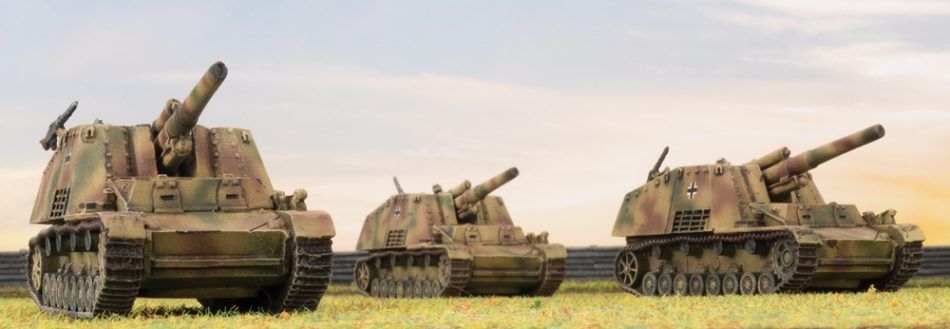 The Command Cards
The Command Cards
The has a number of cards that provide some extra artillery options. The 10.5cm Artillery Battery can be converted into either a or , and the 15cm Nebelwerfer Battery can be upgraded to either 21cm or .
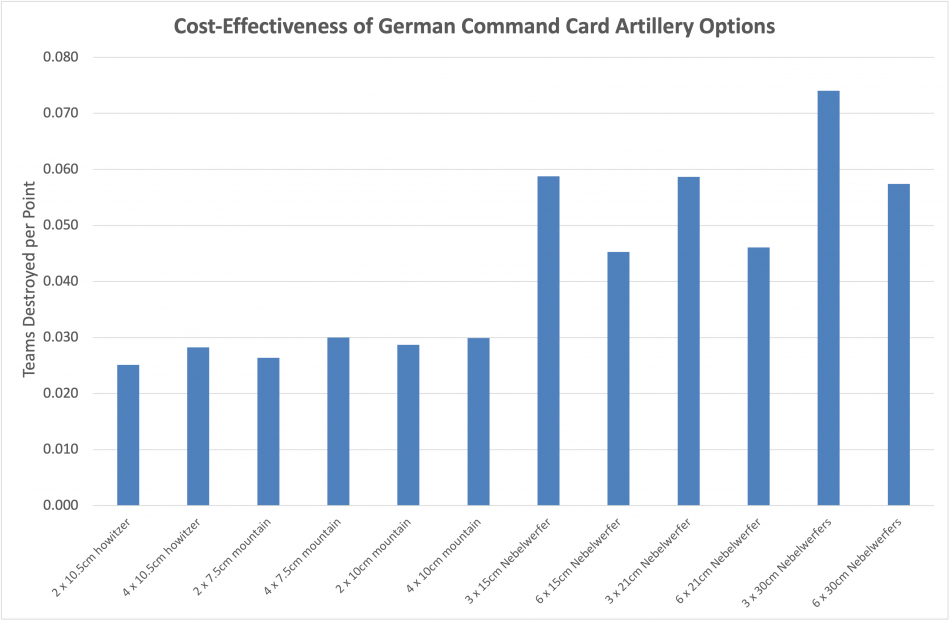
Comparing these Command Card options to their base units, both of the mountain gun batteries are slightly more cost-effective than the 10.5cm howitzer unit they are created from. For the 10.5cm version, this is due to the small points reduction it gets for not having Gun Shield.
For the rocket launchers, the 15cm and 21cm Nebelwerfers have identical cost-effectiveness. The 30cm Nebelwerfer is more cost-effective per bombardment, but this unit is restricted to firing only three Bombardments per game, and the other variants are equally effective when you consider their cumulative performance over five turns.
 German Artillery Efficiency Rankings
German Artillery Efficiency Rankings
I have taken an average of all the results to produce a ranked list of artillery options, starting with the most cost-efficient bombardment, then working down through the next most efficient choice for the points. The units in brackets occupy a slot that has already been taken by another unit higher up on the list.
- 3 x 15cm Nebelwerfer, 21cm Nebelwerfer, or 30cm Nebelwerfer
- 4 x 8cm mortar, 6 x 8cm mortar, 4 x SdKfz 251 (8cm), or 4 x 12cm mortar
- Panzergrenadier 8cm Mortar Section
- 3 x Wespe
- Upgrade to 6 x 30cm Nebelwerfer
- 3 x Hummel
- (4 x Panzerwerfer 42)
- Upgrade to 6 x 15cm Nebelwerfer, or 6 x 21cm Nebelwerfer
- (4 x 10cm mountain gun or 4 x 7.5cm mountain gun)
- 2 x Grille, or 2 x 15cm infantry gun
- (4 x 10.5cm howitzer)
- Upgrade to 6 x Wespe
- 3 x StuH (Formation Support from D-Day: German)
- Upgrade to 6 x Hummel
- 3 x Zrinyi (Allied Support from Bagration: Axis Alllies)
- 4 x 7.5cm infantry gun
- Brummbar
 Summary
Summary
- Two-gun units are more effective when used for direct fire rather than as artillery.
- The different types of mortar all offer very similar levels of cost-effectiveness when taken in units of four or six. They appear to be very well priced relative to each other, and there is no optimal choice.
- The Wespe and Hummel on the other hand look like they are under-costed relative to the towed guns, even after accounting for them having fewer teams in the unit.
- The 10.5cm howitzer is in a really bad place. It is competing with the Wespe and Hummel for a unit slot, its Command Card variants offer better value than the base unit, and it is itself only slightly better value than a unit of StuHs from in a scenario that doesn’t consider the benefits of mobility or Front Armour.
- The best bang for buck? Any flavor of Nebelwerfer.

It would be interesting to look at the SS version’s of the 3 Wespe’s and 3 Nebs. A 22% discount (9 drops to 7pts) and retains the 3+ ranging in. Downside being easy kills for the Typhoons…
Hi Lee, SS Nebs come out ahead of the Bagration ones, and SS Wespes would sit above the mortars on the list. So it looks like the combination of lower price, Rally 3+ and Remount 2+ more than compensate for the 3+ To Hit in these scenarios. Might be different against higher FP direct fire.
The 8 cm mortars look attractive by the numbers but only have a 40 inch range.
Hi Rich, yes I agree, there are some situations where that 40 inch range is going to be a problem. I haven’t found a good way to account for that in the rankings yet.